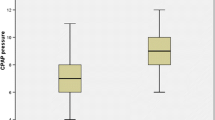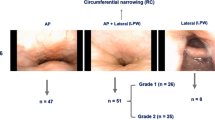Abstract
We studied upper airway structural changes induced by continuous positive airway pressure (CPAP) in obstructive sleep apnea syndrome (OSAS) patients using drug-induced sleep endoscopy (DISE). This prospective study was conducted at an academic secondary referral center. In total, 28 male OSAS patients (mean age 41.1 years) with only retropalatal level obstructions were enrolled. Measurements of the obstruction site were obtained in two steps: first a measurement was taken of the obstruction site in accordance with sleep apnea, then, a measurement was taken of the obstruction site in accordance with DISE-assisted CPAP titration, including quantitative changes in the occlusion site before and after CPAP in pixel format using an area calculation program. There was a tendency for persistent closing in cases of antero-posterior (AP) obstruction versus cases of lateral (Lat) obstruction in the CPAP titration. Lat obstructions showed a tendency to be wider than AP obstructions in the quantitative analysis. These results show that the pattern and degree of airway expansion after CPAP differ in accordance with the obstruction site.


Similar content being viewed by others
References
Young T, Palta M, Dempsey J, Skatrud J, Weber S, Badr S (1993) The occurrence of sleep-disordered breathing among middle-aged adults. N Engl J Med 328:1230–1235
Phillipson EA (1993) Sleep apnea—a major public health problem. N Engl J Med 328:1271–1273
Hertegonne K, Bauters F (2010) The value of auto-adjustable CPAP devices in pressure titration and treatment of patients. Sleep Med Rev 14:115–119
Schwab RJ, Pack AI, Gupta KB, Metzger LJ, Oh E, Getsy JE et al (1996) Upper airway and soft tissue structural changes induced by CPAP in normal subjects. Am J Respir Crit Care Med 154(4 Pt 1):1106–1116
Shepard JW Jr, Garrison M, Vas W (1990) Upper airway distensibility and collapsibility in patients with obstructive sleep apnea. Chest 98:84–91
Stauffer JL, Zwillich CW, Cadieux RJ, Bixler EO, Kales A, Varano LA, White DP (1987) Pharyngeal size and resistance in obstructive sleep apnea. Am Rev Respir Dis 136:623–627
Haponik EF, Smith PL, Bohlman ME, Allen RP, Goldman SM, Bleeker ER (1983) Computerized tomography in obstructive sleep apnea. Am Rev Respir Dis 127:221–226
Croft CB, Pringle M (1991) Sleep nasendoscopy: a technique of assessment in snoring and obstructive sleep apnea. Clin Otolaryngol Allied Sci 16:504–509
Civelek S, Emre IE, Dizdar D, Cuhadaroglu C, Eksioglu BK, Eraslan AK et al (2012) Comparison of conventional continuous positive airway pressure to continuous positive airway pressure titration performed with sleep endoscopy. Laryngoscope 122(3):691–695
Hernandez-Gancedo C, Pestana D, Pena N, Royo C, Perez-Chrzanowska H, Criado A (2006) Monitoring sedation in critically ill patients: bispectral index, Ramsay and observer scales. Eur J Anaesthesiol 23:649–653
Koo SK, Ahn GY, Choi JW, Kim YJ, Jung SH, Moon JS, Lee YI (2016) Obstructive sleep apnea in postmenopausal women: a comparative study using drug induced sleep endoscopy. Braz J Otorhinolaryngol. doi:10.1016/j.bjorl.2016.03.011
Koo SK, Choi JW, Myung NS, Lee HJ, Kim YJ (2013) Analysis of obstruction site in obstructive sleep apnea syndrome patients by drug induced sleep endoscopy. Am J Otolaryngol 34:626–630
De Vito A, Carrasco Llatas M, Vanni A, Bosi M, Braghiroli A, Campanini A et al (2014) European position paper on drug-induced sedation endoscopy (DISE). Sleep Breath 18:453–465
Lopez-Campos JL, Garcia Polo C, Leon Jimenez A, Gonzalez-Moya E, Arnedillo A, Fernandez Berni JJ (2007) CPAP titration: different methods for similar clinical results. Eur J Intern Med 18:230–234
Masa JF (2004) Continuous positive airway pressure titration: manual, automatic, or empirical? Arch Bronconeumol 40(4):147–148
Kuna ST, Bedi DG, Ryckman C (1988) Effect of nasal airway positive pressure on upper airway size and configuration. Am Rev Respir Dis 138:969–975
Ryan CF, Lowe AA, Li D, Fleetham JA (1991) Magnetic resonance imaging of the upper airway in obstructive sleep apnea before and after chronic nasal continuous positive airway pressure therapy. Am Rev Respir Dis 144:939–944
Hoffstein V, Wright S, Zamel N, Bradley TD (1991) Pharyngeal function and snoring characteristics in apneic and nonapneic snorers. Am Rev Respir Dis 143:1294–1299
Rabelo FA, Braga A, Küpper DS, De Oliveira JA, Lopes FM, de Lima Mattos PL et al (2010) Propofol-induced sleep: polysomnographic evaluation of patients with obstructive sleep apnea and controls. Otolaryngol Head Neck Surg 142:218–224
Sadaoka T, Kakitsuba N, Fujiwara Y, Kanai R, Takahashi H (1996) The value of sleep nasendoscopy in the evaluation of patients with suspected sleep-related breathing disorders. Clin Otolaryngol Allied Sci 21:485–489
Hillman DR, Walsh JH, Maddison KJ, Platt PR, Kirkness JP, Noffsinger WJ et al (2009) Evolution of changes in the upper airway collapsibility during slow induction of anesthesia with propofol. Anesthesiology 111:63–71
Schwab RJ, Gupta KB, Gefter WB, Metzger LJ, Hoffman EA, Pack AI (1995) Upper airway and soft tissue anatomy in normal subjects and patients with sleep-disordered breathing. Significance of the lateral pharyngeal walls. Am J Respir Crit Care Med 152(5 Pt 1):1673–1689
Author information
Authors and Affiliations
Corresponding author
Ethics declarations
Conflict of interest
The authors have no funding, financial relationships, or conflicts of interest to disclose.
This research protocol was reviewed and approved after deliberation by the Busan Saint Mary’s Hospital Institutional Review Board (IRB).
Informed consent was obtained from all individual participants included in the study.
Rights and permissions
About this article
Cite this article
Jung, S.H., Koo, S.K., Choi, J.W. et al. Upper airway structural changes induced by CPAP in OSAS patients: a study using drug-induced sleep endoscopy. Eur Arch Otorhinolaryngol 274, 247–252 (2017). https://doi.org/10.1007/s00405-016-4233-9
Received:
Accepted:
Published:
Issue Date:
DOI: https://doi.org/10.1007/s00405-016-4233-9




